The Five Commandments of a Successful Content Marketing Strategy
As a digital marketer or a digital marketing agency, you’re constantly looking to up your game. You want to be the best version of yourself, so you look for resources & how-to’s online.
But let me ask you this question...
Have you ever had the feeling like you’re being duped by the very industry you serve?
As a professional, you are well aware of the different techniques that are deployed to hook in an unsuspecting reader to unconditionally believe the content that is being pushed.
Yet, many content marketing professionals fail to “keep it real,” and emit strong odors of BS that permeate through a computer screen.
This is my promise to you.
I’m going to be as honest as possible, and reveal to you every pillar of truth I have come to uncover during my career in digital marketing.
As an agency, we combine for 40+ years in the industry. We know a thing or two.
What I am not promising is an easy shortcut.
So what’s the bottom line?
In this article, I will dive into the 5 commandments of content marketing. This piece will cover topics ranging from keyword intent, what reader heat maps tell us, the power of emotional copy & authoritative voice, and last but not least, how to separate yourself from the pack.
Let’s dive into it.
1. Understand Your Keyword’s Intent and Tailor Your Content Around That
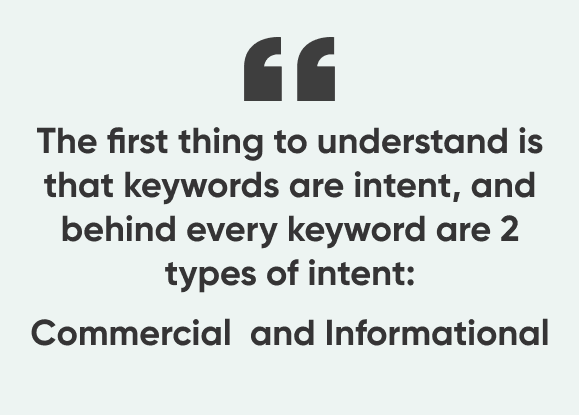
The first thing to understand is that keywords are intent, and behind every keyword are 2 types of intent:
Commercial
Informational
Comercial keywords designate buying intent. These searches are people who are looking to buy something.
Commercial keywords are best suited for splash pages aimed at converting a reader with optimized content and call to actions. Think of an Amazon product page. There are reviews, pictures, clearly defined call to actions, the whole shebang.
Informational keywords designate learning intent. These searches are people who are looking to inform themselves on a particular topic.
This is the most important part.
As a content marketer, you have to understand what your reader's intent will be at the moment they interact with your content.
This means your blog content should exclusively be tailored to informational intent.
In other words, service/product pages = commercial keywords & blog pages = informational keywords.
For example, let’s say that you own a fitness and gym website. You plan on devising a content marketing strategy to drive more sales to your squat rack product page.
Since you’re not Bodybuilding.com (and you don’t have immense brand recognition), you are going to need to drive traffic to your site with informational queries, and funnel them to your product page to convert them into a sale.
Start by optimizing a blog post around an informational query, like “best home gym equipment.”
Don’t aim to get a user to buy anything on this page, simply inform them on your honest thoughts.
Why?
Because the intent behind “best home gym equipment” designates that the reader isn’t ready to buy yet.
Now just because the intent behind a keyword is informational doesn’t mean it will stay that way. A reader’s intent is subject to change, and if you’ve done your job well enough, you will convince the reader that your word is trustworthy and your products, services, or recommendations are worth buying (more on that later).
You can lead the reader down the funnel by strategically placing your main call to action in the right areas to guide them to the right pages. So essentially, although your reader’s intent was initially to gather information, it transformed into a commercial intent after reading a really good blog.
So how do you create a blog that’s really good? Well first, start with creating a great introduction.
2. The Intro is Really, Really Important
Take what you learned in high school about the most important part of a piece of content being the body and throw it out of the window.
The intro is the MOST important part, hands down.
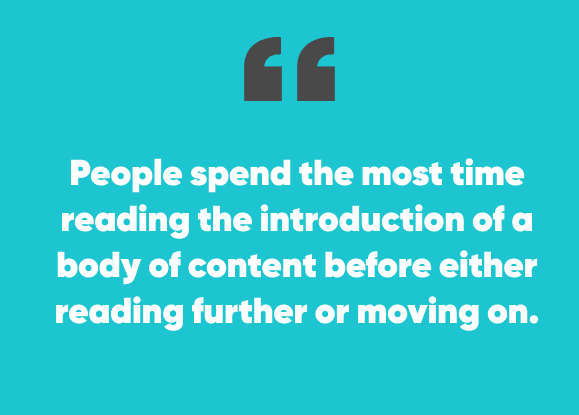
Plenty of heat map studies support the theory that people spend the most time reading the introduction of a body of content before either reading further or moving on.
What does that mean?
You must earn the trust of your reader that if they invest their time in your content, they are not wasting their time.
No, I don’t mean to hook them in with overly promissory statements just to get their attention and hope they don’t get upset when they reach the conclusion and realize that they wasted their time.
This is the important part.
Provide actual value in the intro.
For example, if you’re writing commercial content (see above for more in-depth definition) like a service page or a product review, place the pertinent information at the top so readers who scan read can gather the information they want while exerting minimal effort.
If you’re simply writing an informational blog, be sure to fully reveal to the reader what you will be covering so you can give the reader an informed choice as to whether or not they want to keep on reading.
Once you’ve created a phenomenal intro, writing the meat of the content comes into play. In my experience, there’s one rule that rules all, write value-driven copy that hits on people’s primary drives and emotions.
3. The Power of Copy That Speaks to the Reader’s Feelings
The difference between a good writer and an “eh” writer is a fine line. Good writers are far and few between; “eh” writers inundate every nook and corner of the internet.
Good writers make themselves stand out by knowing how to use copy that speaks to the reader’s emotions.
Here’s the deal.
People don’t base decisions on rational step-by-step processes they’ve cultivated over the years (at least most people; there are no absolutes in life, right?).
Simply put, people tend to make decisions based on emotions.
So what makes emotional copy so powerful?
Let’s take a step back and understand that when a user uses the internet, they are inundated with choices.
When a user goes on the web with the intention of learning more about something and potentially buying a product or service, the number of choices they are presented with is overwhelming.
There is plenty of literature, highly influential books, and TedTalks given on this very subject.
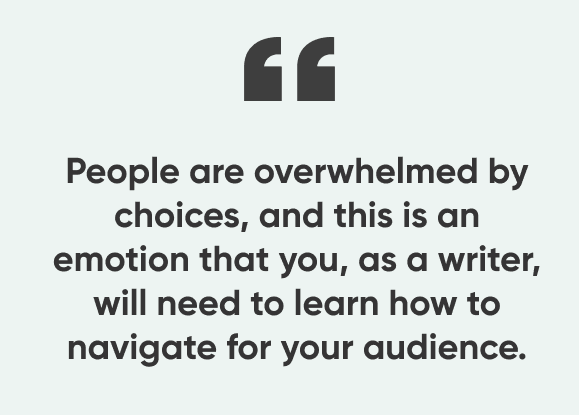
People are overwhelmed by choices, and this is an emotion that you, as a writer, will need to learn how to navigate for your audience.
Good copy that speaks to a reader's emotions relaxes the reader.
It eases them, and allows them the space to buy into an idea (if you’re writing information copy) or buy into a product or service (if you’re writing commercial copy).
Your writing should be answering any objections a reader might have. It should also tell readers what isn’t right for them.
If you believe a product or service that you are selling isn’t right for a particular type of person, say it!
Reducing the anxiety of choice goes both ways, by showing what is right and what is not.
Aside from speaking to a reader’s emotions, communicating through an authoritative voice can cultivate trust, here’s how.
4. Use an Authoritative Voice
Let’s do a thought experiment. When was the last time that you read something online and thought to yourself, “man, this person really knows what they are talking about”?
Now, this next question may sound a bit counterintuitive.
Was this person writing about facts with citations to back them up? Or were they talking about their opinions?
The truth is, the answer is probably the latter.
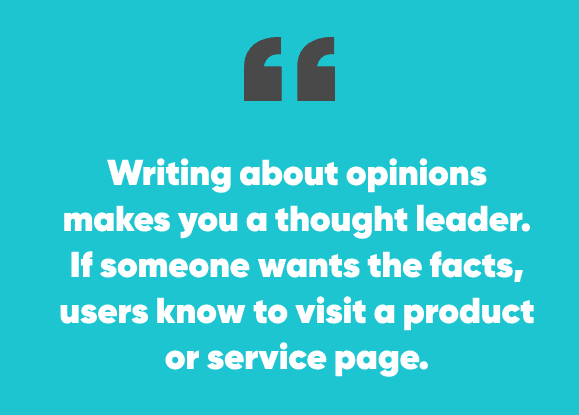
Writing about opinions makes you a thought leader. If someone wants the facts, users know to visit a product or service page.
Think of Amazon. Let’s say you’re a consumer looking for the dimensions of a certain product; you can go directly to the product page to get that information.
Let’s say you’re a business owner looking for a new CMS (like Squarespace or WordPress). If you’re interested in which one is compatible with Shopify, you’ll most likely go to the product page.
In both cases above, you are looking for facts.
But here is the kicker.
Content marketing isn’t about spewing facts, it’s about stating your opinions from a position of being a thought leader.
People don’t trust product pages because they know they are being sold.
People trust thought leaders because they have less bias.
This is the same concept behind influencer marketing. For instance, influencers talk about their opinions on video, and people listen (for the most part), as long as they position themselves as a thought leader.
Good content marketing strategies do the same.
As long as you’ve done your job right, placing a link to your product/service page in the appropriate spot will allow your reader to click on it with the confidence knowing that they are making the right choice, free from anxiety.
Trust doesn’t come that easy though. As a content marketing strategist, you will need to gain a reader's trust in more ways than one, and one other way is to create great unique content.
5. Separate Yourself From the Blehhh Content on the Web
This one should be the easiest of them all. If you’ve read this far, you’ve already accumulated enough knowledge to create better content than 95% of the stuff that’s already out there.
Essentially, the main message behind this pillar is to create original content.
No one likes regurgitated and recycled content on the web.
Even Google is starting to not like it (I’m looking at you SEOs).
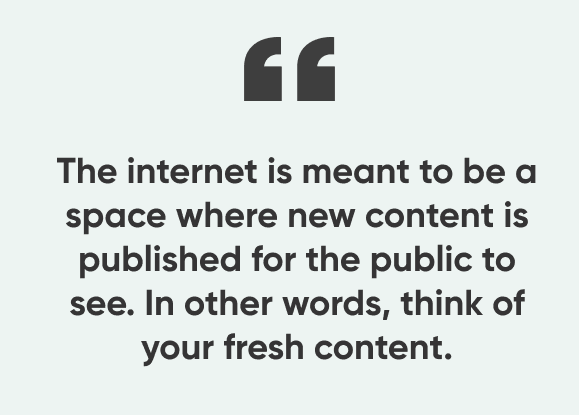
The internet is meant to be a space where new content is published for the public to see. In other words, think of your fresh content as the bibliographic (original) source for others to link to.
There is immense value in that.
Also, don’t be afraid to knock other ideas, respectfully of course. Being real and voicing your opinion cultivates trust with the reader, even if they don’t agree with you.
Final Words...
Developing an effective content marketing strategy is an important aspect of an overall successful marketing campaign.
Although content marketing is one small aspect of marketing altogether, it pulls its weight in importance. Without it, all other aspects of a campaign risk underperforming.
By targeting keywords with the right intent, you will be driving the right users to the right pages on your website, thus raising the potential that they will have a great experience (and maybe even convert).
With a great introduction, you reel the reader into wanting to read the rest of your content, thus raising the chances that your reader will funnel to the right pages.
By speaking to a reader’s emotions, you are able to reduce their anxiety from the plethora of choices on the web.
By cultivating an authoritative voice, you create a strong sense of trust with your reader. This kind of trust is of utmost importance when creating a readership that will return to your site in the future when the need arises.
By creating unique content, you provide your readership with linkable pieces of content that, once again, raise the trustworthiness of your content. This kind of trust can be lent to the brand in and of itself, which has its obvious benefits.
Bottom line, a great content marketing strategy creates a great user experience, reduces stress, and cultivates trust with the reader.
If you’ve made it this far, hopefully, I’ve been able to do just that with you. :)
